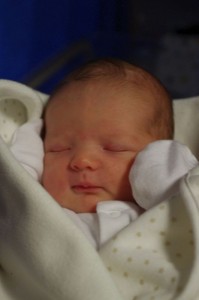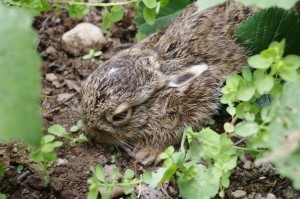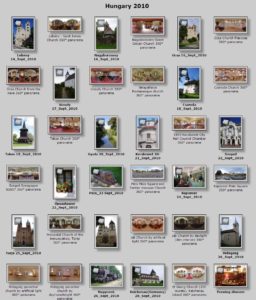To download a printable Adobe Acrobat version click on this link E2E2011_issue_1-Hot and cold.pdf (four A4 pages).
Clicking on a photo will take you to a larger image.

Jacob 13 Mar 2011
The most exciting event of 2011 for us took place in London rather than in Entre-deux-Eaux.
It was the birth on March 11th of Toby and Stella’s son Jacob Toby. He is, of course, absolutely gorgeous, and we enjoyed sharing his early days. We’re looking forward to meeting up with them at the end of July in Antibes and seeing all the changes. The rest of the year seems mundane in comparison, but here’s a summary:
The cold winter did not cause as many problems here as it did in the UK as people are prepared for it. John had bought winter tyres, which many people use here, – but he had the UK problems in mind. Madame Laine had to think quite hard about the weather when we returned in early January from Christmas and the New Year in the UK, but then recalled that there had been snow up to her knees over Christmas, which was a bit of a nuisance when going out to feed the hens. The roads had suffered in the cold weather, and on our return journey there were plenty of notices announcing “trous en formation”, which always (quite irrelevantly) conjure up images for me of the trous/holes lining up solemnly for a bit of formation dancing – or even a can-can. Unfortunately our fridge freezer had given up hope while we were away; with minimal heating left on, the room temperature went below the climate class rating, so we came back to the freezer contents in a sticky pool on the kitchen floor.
The dull January days outside passed quickly indoors thanks to a Christmas present of a huge jigsaw puzzle, John’s ongoing project of scanning all his negatives and transparencies, and Helen’s attendance at AGMs, which can include protracted lunches (the oldies of E2E) or interesting old films (the local history group). We had toyed with the idea of travelling to Tunisia where Jessica’s sister and brother-in-law were over-wintering on their sailing boat (another retirement lifestyle). But as we listened to January news bulletins, February seemed a very bad time to visit (though Jessica and Mark had a good time there in March, when things were settling down).
However, February was put to good use when John finally cleared his wardrobe of old shirts which I dismembered and turned into a patchwork quilt for Jacob with other bits of hoarded fabric. There was an amusing trip to the amateur theatre group over the mountains in Saulxures. After a large lunch, the audience, drinks in hand, settled back from the long tables to watch a play about a local council election. If that sounds boring, the plot was sheer French farce, – with one of the mayoral candidates desperate to maintain his respectable reputation after having sex in a ‘plane toilet with his long-lost brother (who had undergone a sex change operation). The audience found it hilarious, though my A-level French didn’t quite cover all the vocabulary! February was also notable for a trip to the Auberge de la Ferme Hueb restaurant, one of our favourites. The night before had been a special St Valentine’s meal, and I think we were the beneficiaries of their left-overs. The meringue swans were exquisite. The muscat aperitif was so good that we drove home via the producer in the small village of Hunawihr. On learning that we lived over in the Vosges department, he regaled us with Alsatian jokes about Vosgiens, and their poorer climate, such as, “Why do Vosgiens have big ears?” “I don’t know, why do Vosgiens have big ears?” “Because when they are small, their parents lift them up by their ears to show them how much nicer it is over here on the other side of the mountains in Alsace.” Maybe he was bored and we were his only clients that day. Out in the yard a mobile bottling machine was clanking away, – presumably rented for a day or two. We tasted a few more wines (he was anxious that we should try his medal-winning crémant) and departed with boxes of his pinot gris and gewurtztraminer as well as muscat.
We also had a trip in early March to a Colmar restaurant, L’Atelier du Peintre, which is fast joining our list of favourites. It was harder to book than previously, as it had just been awarded a Michelin star, and everyone wanted to be there. The two portly men at the neighbouring table, who were working their way through some expensive-looking wines, sounded as if they had been local politicians. I ironically asked Madame if Gordon Ramsay had congratulated them on their star, having once featured them on his Kitchen Nightmares when they were running a restaurant in Inverness; Loïc and Caroline had been plucked from the south of France by a Scottish tycoon to create a restaurant capable of getting a Michelin star. Ramsay hadn’t.
Any trip to the UK, even one for the birth of a grandson, involves stocking up with wine from France for family and friends and then, on the return trip, with a weird assortment of goods that are cheaper or easier to purchase in the UK. This time, on our return, the back of the car contained an upright Dyson vacuum cleaner (the French don’t seem to do upright ones), garden netting (woven for a very reasonable price in an industrial estate in Huddersfield very close to where distant ancestors had once owned weaving mills), pesticides, fertiliser, seeds (all very expensive in France), second-hand books, and a wedding hat (no, not for the royal event). It was beautifully sunny as we crossed France and the white blossom of blackthorns and damsons was splashed across the fields south of the champagne slopes. Back home we found fritillaries in flower under the plum tree and the peonies bursting out of their winter wrappings.
April was notable for the glorious sunshine, so it was tempting to start sowing seeds a bit earlier than usual, whilst John got busy constructing a large (12m x 4m) walk-in fruit cage from posts, wire and the above netting. As so often here, even visitors got involved in a bit of gardening. Jessica brought various plants from their Putney garden when they stayed at the end of April, and Mark christened us Natasha (Jessica in her scarlet patterned headscarf wheel-barrowing compost) and Vanessa (Helen in her floppy straw-like hat bending over weeds and seeds). While they were here we also got in some good walking on the mountain ridge (spectacular views down into Alsace without our ears being stretched), a trip to see le Corbusier’s lovely church at Ronchamp, a birthday lunch in Saulxures, a rhododendron garden, and the royal wedding (on TV). The French, despite their vehement denials, remain strangely interested in other countries’ royals. Throughout April we had been asked jokingly if we had been invited to the wedding. At Ronchamp the baker had treated us to a half hour discourse about Le Corbusier, the royal wedding, strikes and the superiority of the republic over the monarchy. At a book-sale, the secretary of the local history group and her assistant had a long discussion with me about the wedding outfits and the hats, – “such a disgrace, that princess Beatrice and that Eugenie. How could the couturier have permitted it?” Even the mayor of Entre-deux-Eaux had joked, as he led a walk along local footpaths, about whether we’d be attending the wedding!
The mayor’s walk was as a result of one of the January AGMs, that of the Entre-deux-Eaux oldies. Before lunch various radical proposals had been made including adding walking to the more sedentary monthly activities of cards, gossip, cakes and crémant (a proposed trip round a brewery in Alsace had also gained vociferous support from the men). The mayor’s walk was idiosyncratic, with throw-away comments about residents past and present. He inspected the dustbins of some German week-enders – “he’s an advocate, but thinks he can do what he likes over the border. But all I have to do is threaten to call the gendarmes (not that they’d come) – that always stops a German.” As we climbed up to an isolated farm two km from the village shop and café, – “the old man was a drunkard; he walked down every night to the bar, and faced an uphill struggle back!” Outside a picturesquely ramshackle farm, – “no running water – see the hose pipe coming down from the spring in the fields, across the road and into the house – no legal sewerage and that muck heap’s now illegal under EU regulations.” EU rulings lead to great expense for the commune too; a whole area round the pipes leading from a spring to one of the village reservoirs has had to be cleared of forest and fenced off to prevent contamination by deer and other animals. Then he led us past a World War I defensive bunker (the Germans had occupied the village below for a while) to a house buried in the forest, so we could see the finest stone carving in the commune (ironically it is now occupied by Germans). In the middle of the forest peace, a fellow-walker’s mobile phone rang. “Reception is usually impossibly in the forest. Have you been contacted about the new mast? Someone near you is organising a protest. I don’t understand them. People here want all the modern technology like mobile phones, but not the consequences.” Later we heard that the protesters had organised a meeting and succeeded in convincing the mayor not to allow a mast.
April was also when the flea markets started. We still go as an enjoyable Sunday outing but buy fewer things these days (we have enough already). However, occasionally we can’t resist. At the St Remy Foire au Lard, which has a lot of stalls selling chunks of smoked pork, we spotted (in a separate section from the lard) a pile of Art Nouveau magazines in English. They were issues of Studio from 1902-1905 with fascinating illustrations of houses and paintings; even the advertisements were beautifully lettered and designed. You wouldn’t have thought there was a big potential readership at a Foire au Lard, and indeed the price was reasonable. We bought the whole pile. The bare walls of our small flower garden have long been in need of some ornamentation. Old farm implements or wrought iron deer are the usual local wall decorations. However in another small village fair, John spotted a box of corroded brass instruments, – fragments of trumpets and trombones which looked as if they had festered in a damp outbuilding after the members of some long ago village band had died. A musical garden will be a bit different. At the same village we also saw rusted weapons of the WWI found with a metal detector (presumably illegally) in the hills above. At the Entre-deux-Eaux flea market I bought some plants, including geraniums. And at nearby Corcieux, Alistair spotted a replacement blade for a nine-inch angle grinder which he was sure John would need.
Alistair came over in May (it is becoming an annual event) to help John with various large projects. He laid paving slabs over the whole area that they’d cemented last year (panorama of the completed new terrace). The slabs proved difficult to cut and Alistair finally persuaded John to invest in a nine-inch angle grinder. So the cheap (but brand new) replacement spare blade was a good purchase! One day the ready-mix cement lorry blocked the road outside our house (we had warned the neighbours the night before) and as the wet mix was hosed into the barn, Alistair and John spread and levelled nearly eight tonnes of it until we had a smooth new floor. They also created ramps and steps down to the terrace and garden. That was an impressive day’s labour. John is currently re-wiring the barn, tiling the floor and putting plasterboard on the old stone walls. In the end the barn that used to have the cattle stalls (and still has a water trough) should make a more elegant entrance area for the “West Wing”. It should also be a lot safer with a level floor, without cracks and without gulleys for swilling out the stalls and pens. In some ways it’s sad to change things, and it doesn’t comply with energy-inefficient heritage conservation ideas, but will be more practical (as local farmers always were).
After the hot dry days of April and May people here, as in England, were fearing for farms and gardens. But June is making up for it with its heavy showers and thunder storms. Our underground water tanks have filled again. But the gardeners’ good news was bad news for all the barbecues, Bastille Day fireworks, St Jean bonfires, school fêtes and open air craft fairs traditionally held before the long school holidays start on 1st July. Men with marquees have been kept busy. On Sunday it was the Fête du Pain with a barbecue at the farm museum at Sainte Marguerite. Everyone arrived in anoraks and warm pullovers, to find the sturdy trio of old fashioned marquees well tethered (after one had landed in a neighbouring garden in a previous year). At the back of the old farm the lamb gigot was being grilled over a barbecue whilst in the tents the mayor of Entre-deux-Eaux was presiding over the bar and a young accordionist was playing as the aperitifs and then the home made foie gras paté were served. Later Mme Presidente and a group of friends brought out some old musical instruments and played before we were served cherry clafoutis cooked in a wood burning oven. Later, in the tombola, the agreeable Dutch couple at our table won a miniature sledge wine bottle holder carved by an old man at the next table. And the rain miraculously held off between 11 and a couple of minutes after we got home. We were equally fortunate with the Sainte Marguerite pensioners’ barbecue by the pond of Monsieur Nicolas. The men had put up the more lightweight and modern marquees that morning and were barbecuing the pork slices and sausages, whilst the women served the sangria, the salads and the desserts. For some reason the usual accordionist was not there, but that didn’t stop the dancing to taped music and the very jolly conga I got swept up into. We beat a strategic retreat as the skies darkened and were home just before the rain heavy rain started.
And to end where we started, – with a baby, this time a furry one. From our window we have in the past seen deer, buzzards and a stray stork. A few days ago we saw two shapes in the field, the usual cat hunting and something with longer ears, – a cat-sized hare.

Leveret – 10 June 2011
A bit later, as John was walking to the back door to his workshop the hare shot out of the flowerbed. As John was showing me its footprints, he spotted its baby, eyes wide open, fearless and adorable. Sadly, shortly after he took its picture it must have been removed to a place which felt safer and we haven’t seen parent or baby since.
Au revoir!




